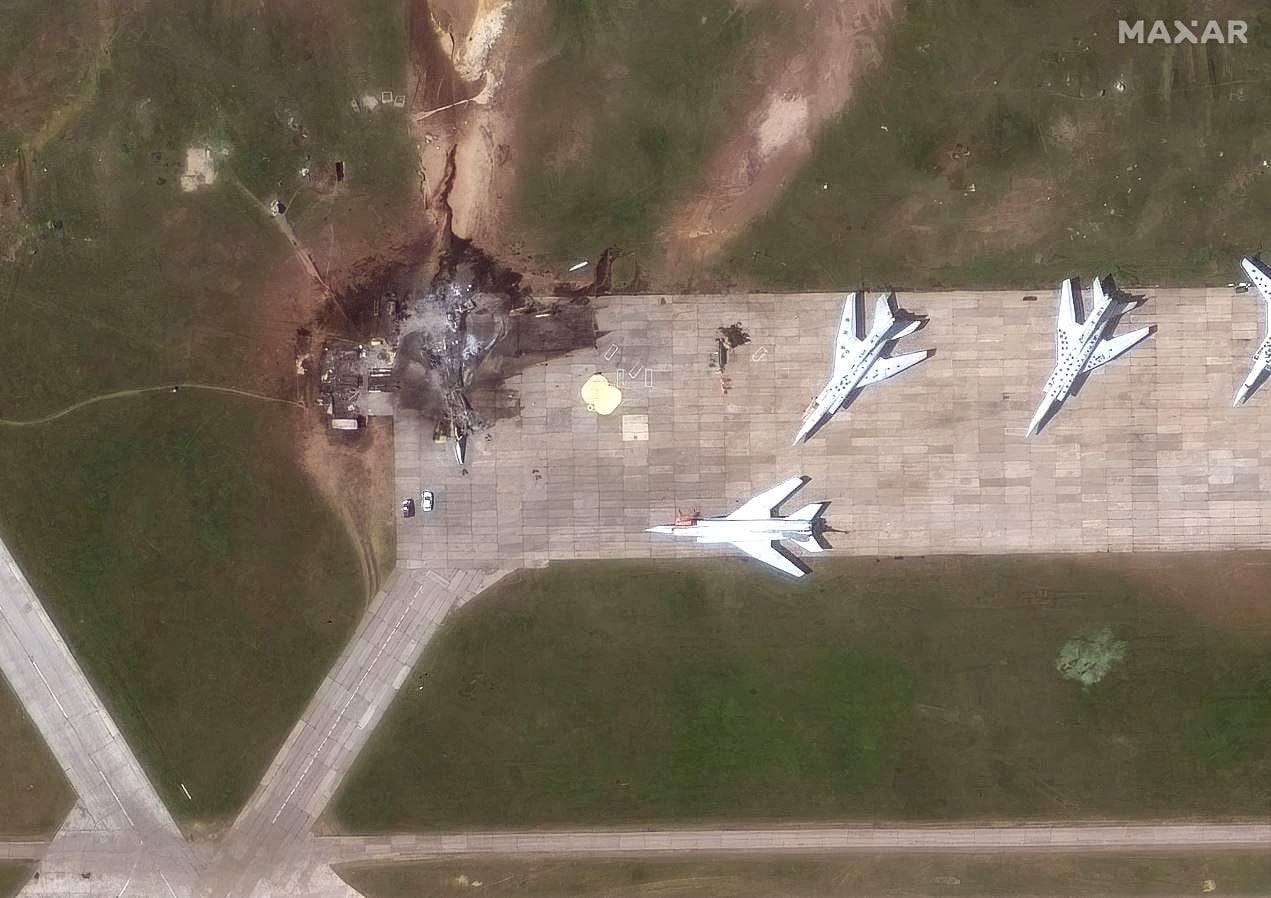Interesting analysis of the Ukrainian drone attack on airfields using unwilling truck drivers. And it betrays that it was more PR than substance, which you have to think was the purpose. And since this war is profiting military industrial complexes on both sides, you’d have to say mission accomplished as a lot more hardware will be sold and it pushes peace farther away.
https://anti-empire.org/p/operation-spiderweb-great-success
Russia has too many airframes and too few missiles for any of this to matter
By Marko Marjanović
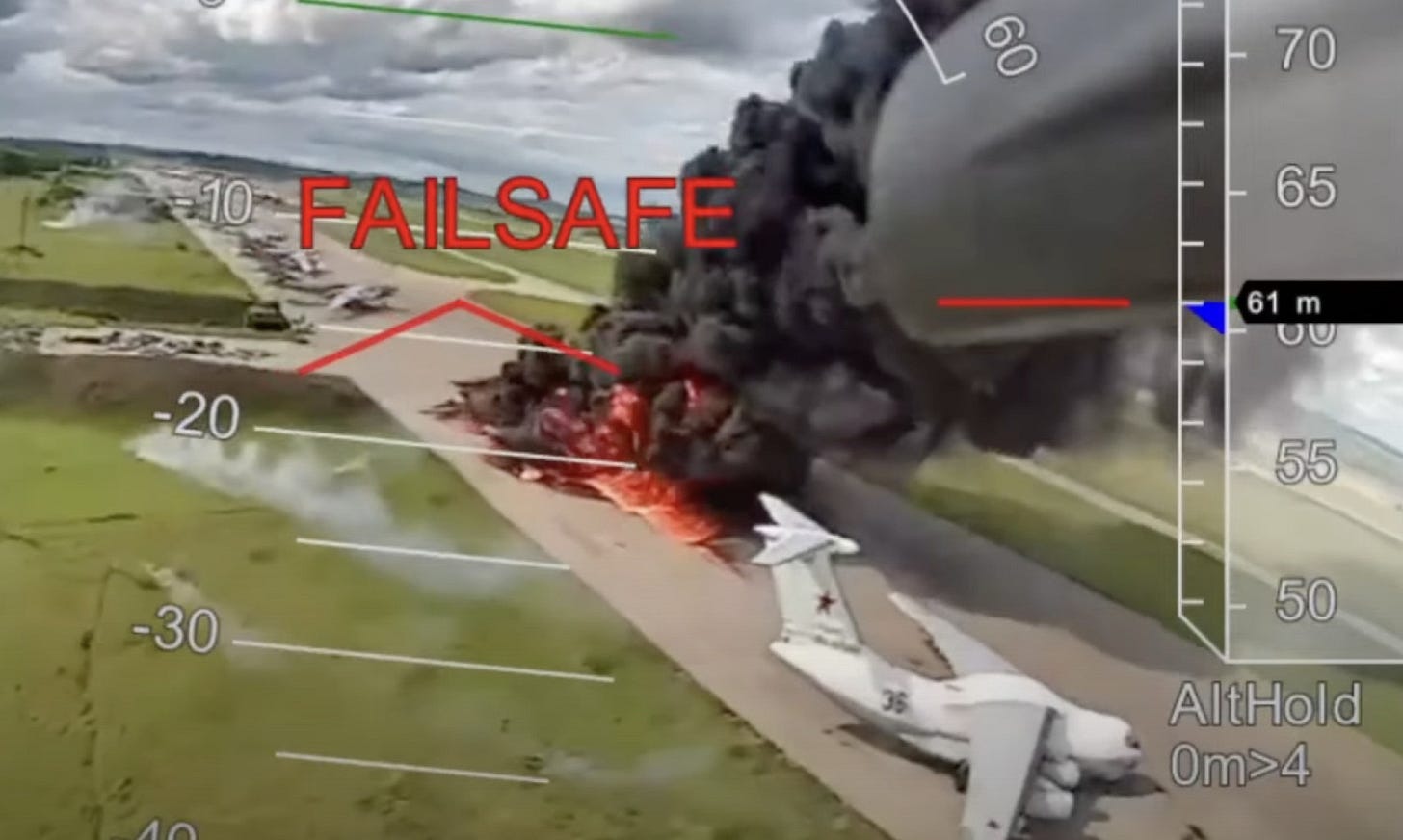
In the final tally the Ukrainian June 1 truck-launched drone attack on Russian airbases in the interior destroyed around 12 heavy bombers, mostly Tu-95 but also Tu-22M, 1 An-12 transport plane, and 2 decommissioned A-50 airborne radar planes with an analogue electronics suite and engines long removed. It also damaged a handful of more aircraft, again chiefly Tu-95 and Tu-22M.
The ethics of using unwitting civilian truck drivers in the attack aside, it was surely a very innovative and highly successful warfighting enterprise, but the more important question is; is it a form of attack that can be successfully repeated time and again, and if it can not be, will it have any impact on the war at hand?
At the very least, in the future it will surely be much more difficult to get commercial truck drivers to accept deliveries to rest stops in the immediate vicinity of major military installations. Also, the airbases in the interior may henceforth deploy a sentry of radar-guided anti-aircraft guns active 24/7. Three years into the war Russian airbases are also now slowly acquiring aircraft shelters, albeit so far this has mainly been the airfields in the west that are in range of Ukrainian An-196 flying bombs (“drones”).
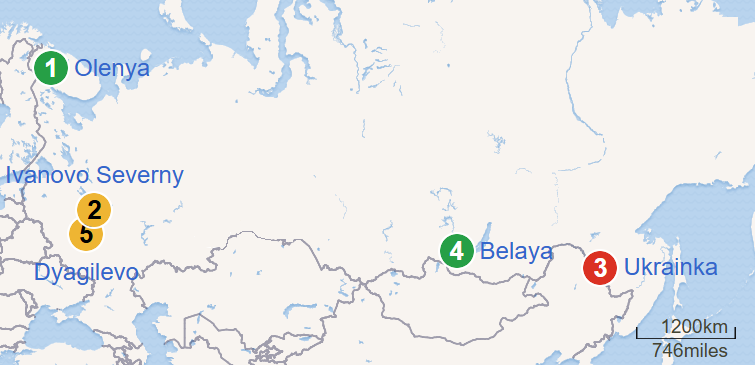
The Ukrainian operation targeted five airbases, in one case the truck failed to reach the airbase, and at two bases no operational aircraft were destroyed in the strike. Incidentally, the two bases that came under attack but were left mostly unscathed are in the central part of Russia around Moscow and must therefore maintain active defences against An-196 long-range drones.
The Russian embarrassment of airbases in Murmansk and Siberia suddenly erupting into flames, helpless against tiny explosive toys, aside, a potential repeat attack would have to be even more complex (eg Ukrainian truck drivers) to defeat additional challenges. Yet even in the first attack, which had the advantage of full surprise on its side, 60% of the attempted strikes failed.
But what of the extent of the damage already inflicted? About a third of the bombers destroyed were Tu-22M. So far this type hasn’t been greatly relevant to the war at hand. It was built to fire large supersonic ship-killing cruise missiles which have at times been reconfigured for land attack and used in Ukraine, but rarely so since that’s not particularly economical. It was also used to rain down dumb bombs on Azovstal in the opening stage of the war, but that was a special situation with Ukrainians encircled and their air defenses far away, which is unlikely to repeat.
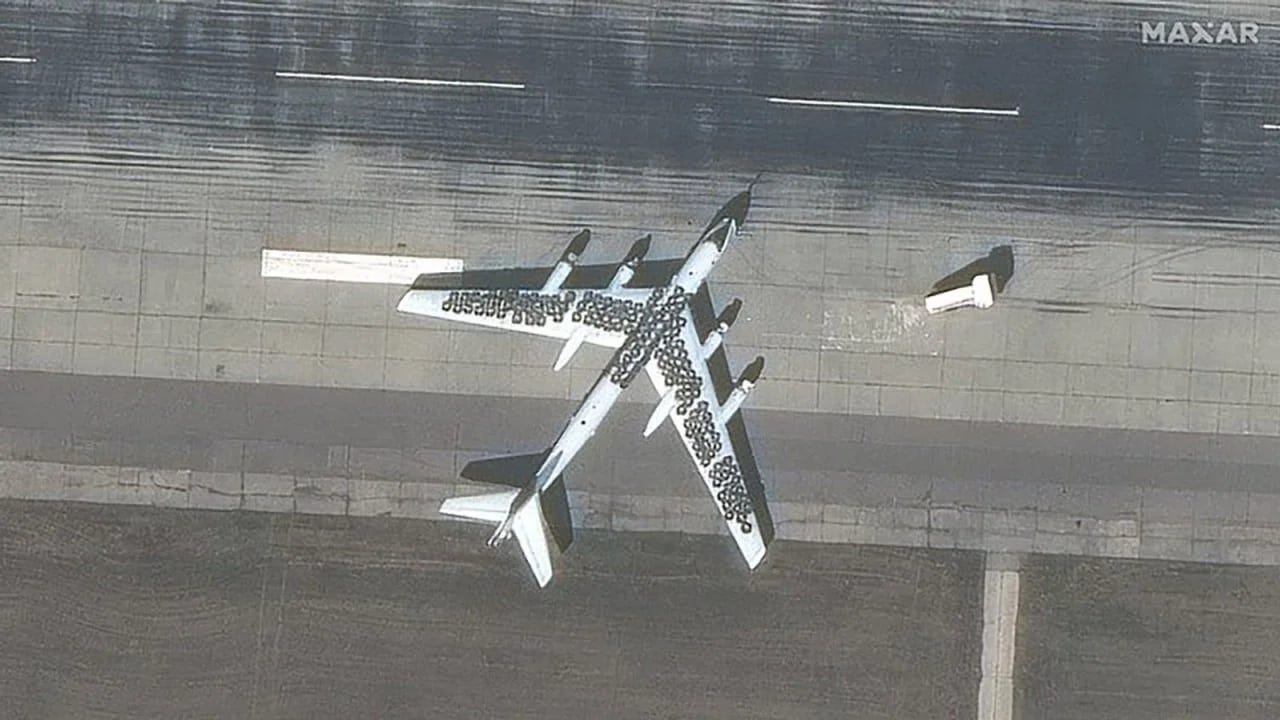
Placing tires on aircraft for protection has been widely ridiculed, but according to Zelensky the attack involved “117 drones and 117 human drone operators”, if that is true, then the tires did their job. They made an attack by program-piloted drones too uncertain and forced a more complex operation involving human pilots. The tires work similarly to captchas online. They obscure the shape, interfering with machine object recognition. (Ironic since internet bots have been able to solve captchas online for many years now.)
Along with Tu-160, the Tu-95 is used to fire the subsonic Kh-101 cruise missile (roughly a counterpart to the US Tomahawk), which along the Iskander ballistic missile and the Geran-2 flying bomb has been a pillar of the Russian strategic bombing campaign. Thus at first glance destroying around eight Tu-95 airframes seems like it could bring Ukraine some welcome relief from the Russian strategic bombing. But the reality is that the bottleneck for the Russians isn’t airframes, but the missiles. Whether framed as an extreme over-abundance of Russian delivery vehicles, or an extreme Russian missile famine, the fact is that even with the reduced heavy bomber fleet Russia could easily launch 20 times more missiles than it is currently producing and expending.
Ukraine estimates Russian Kh-101 production at 60-70 pieces monthly, which means that Russia must stockpile weeks and even months of production to launch a credible salvo attack. — Indeed, according to Ukrainian data, Russia launched 57 of these cruise missiles in May, 55 in April, 34 in March, 6 in February, 40 in January. That’s 192 for the first five months of 2025. (It launched 149 in December, and 249 in November, but now it’s clearly back in conservation and stockpile mode.)
Now consider that a single Tu-95 can mount up to eight of these missiles and that some 40 remain. A Tu-160 of which around 16 are in service can mount twelve. Albeit it’s almost never used in this role a Tu-22M of which 55 remain is also able to fire Kh-101s, and with some modifications, so can the Su-34 tactical bomber of which 350 serve.
The reality is that a tempo of some 800 Kh-101 fired yearly is much too low for airframe losses to have any bearing on Russia’s ability to sustain it. For example, when it comes to tactical glide bombs, Russia now delivers 800 of them every six days. If you’re looking for aircraft that are being heavily utilized, it’s the Su-24 and especially Su-34, which are delivering the 150 daily glide bombs in at least 40 daily sorties.

Nor is there any indication that Russia’s cruise missile production will skyrocket to test airframe availability anytime soon. In fact the first half of 2025 has seen Russia scale its Geran-2 flying bomb production, but since the early manufacturing increases of 2022 and 2023 Kh-101 numbers haven’t been climbing. (Seeing the $35,000 Geran-2 is thirty times cheaper that’s perhaps understandable, but with low kinetic energy and a small 50-kg warhead, the small nuisance flying bomb simply can’t accomplish Kh-101’s mission profile. During 2024 Russia systematically dismantled Ukraine’s coal-fired power-generation capacity, which required punching through roofs and then delivering severe damage to very heavy and massive machinery on the floor, something a Geran-2 is unlikely to do. The trick is that with a comparatively short and low-tech supply chain, the production of Geran-2 is much easier to scale.)
Salvo size is also no issue. The largest to date has involved around 90 Kh-101 — a number that could be accomplished by as few as a dozen Tu-95.
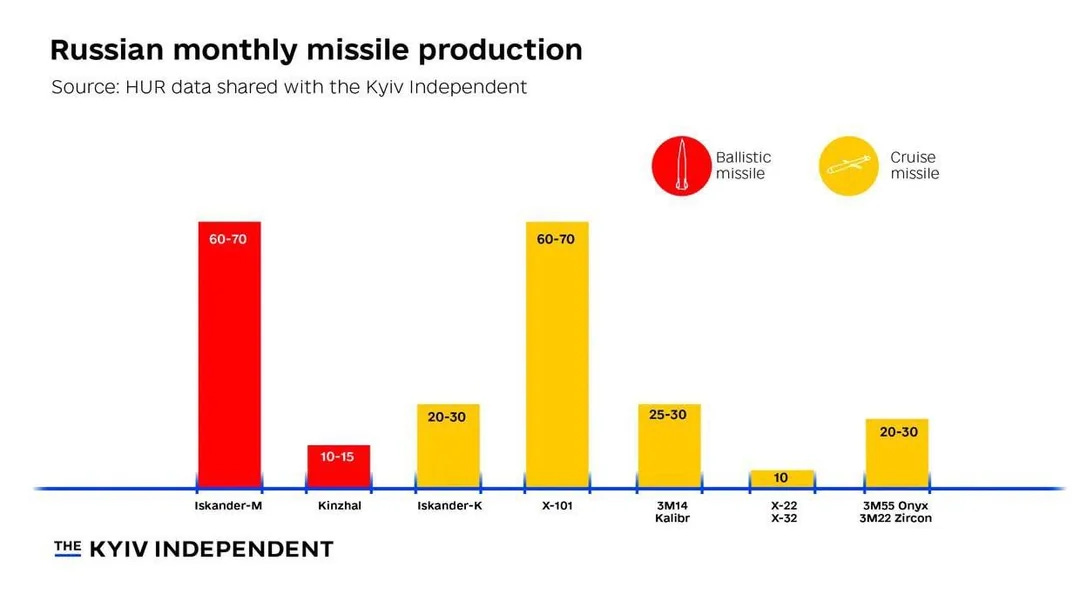
Operation Spiderweb then will be one of those moments that rallied nationally-minded Ukrainians, filled them with pride, and that they will remember until the rest of their lives, and that pupils will perhaps one day learn about in school or be memorialized in a spy thriller. But as it stands its consequences for the war at hand won’t be much more than forcing Russia to devote more resources to protecting even those airbases far from the theater. Indeed, even just on the day of the attack a total of over 300 ground soldiers from both sides combined perished — even on just this one day the meat grinder was the most central and consequential aspect of the war.

“Strategic Bomber” and “Triad”
What about the consequences past this war? What about the fact Russia lost “10% of its strategic bombers” in a day. What’s more, supposedly even its “nuclear triad” has now suffered a blow.
Here’s a thing. The Russian military has some 4,000 aircraft, of which nearly 2,500 are fixed-wing. Yet it chose to keep around just 48 Tu-95. The Tu-95 isn’t a massively expensive or complicated plane to keep around. If it wanted to, Russia could have kept more Tu-95 in service at the expense of some other aircraft types. But it didn’t do so. Because it figured that given the resources available, the type was just important and useful enough to warrant 48 pieces, 2% of the force. Force structure betrays what militaries think is important and the Russian one clearly wasn’t going to massively invest in the Tu-95 fleet. In fact, not all are even yet in the modernized “MS” configuration.
We have to distinguish what the Tu-95 was in 1955 and what it is in 2025. Yes, the Tu-95 was conceived as a nuclear strategic bomber that would fly over the Arctic, penetrate through Canada and then drop free-fall atomic bombs on the US. The success of such a mission was probably already dubious even at that time, but it was a high-performing aircraft for its time, and state-of-the-art technology.
Even so it was made obsolete in just a decade of service by the mid-1960s advent of the ICBM, which was infinitely better at Tu-95’s nuclear holocaust job. Much like its US counterpart, the B-52, albeit obsolete for the atomic job it was built for, the Tu-95 stayed in service, because other less critical missions were found for it. The B-52 carpet-bombed Northern Vietnam, and the Tu-95 found work as a maritime patrol aircraft, tracking US naval assets across the world’s oceans. Indeed, today nearly 40% of the Tu-95 family of aircraft serve with the Russian Navy as the Tu-142, an anti-submarine derivative of the Tu-95.
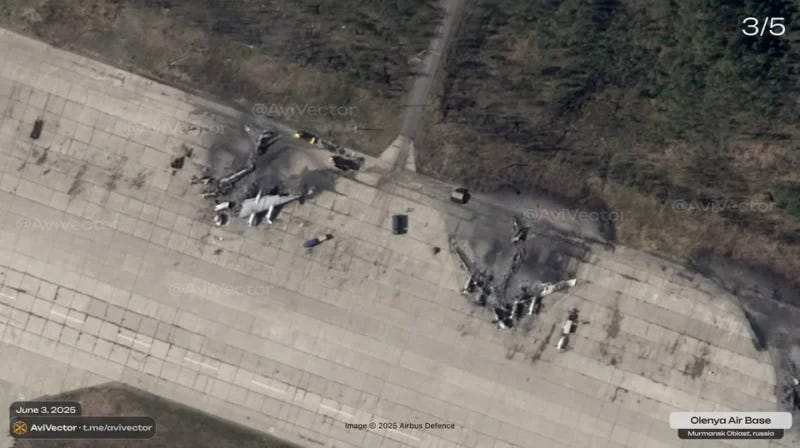
What the Tu-95 is in 2025 is a low-tech, relatively cheap-to-fly, cheap-to-maintain, low-performance, aircraft with extreme endurance. These characteristics make it useful for some mission profiles. Eg it can carry anti-ship cruise missiles deeper into the Pacific than any other Russian aircraft, and can missile-bomb Ukraine from airbases that are theoretically out of Ukrainian reach. But the idea the Tu-95 would have a role to play in a nuclear WW3 other than a desperation weapon is fanciful, and like in the US has more to do with budget wars among the military services than the reality of WW3. The air leg of the nuclear triad has for half a century now been distinctly the most junior of the three and bordering on more marketing than actual.
Consider that a subsonic turbo-prop is far cheaper than an ICBM, yet Russia has far more of the latter than of the former. Surely if Tu-95 had a real role to play it would given its relative cheapness, be around in very substantial numbers. Instead, the Russian nuclear planners clearly believe that even at its inexpensive price, it’s still much less economical than an ICBM and virtually not worth keeping around. As for the American nuclear planners, the Tu-95 is at the very, very bottom of the things they worry about. Consider that aside from being more numerous, Moscow is now attempting the 5th successive modernization of its ICBMs, while money for upgrading the alleged air component of the “triad” was never allocated. — Because there is no update that is going to make a manned nuclear bomber better than a missile falling from space.
Indeed, we’re in a situation where just yesterday it wasn’t uncommon to ridicule Russia for even still keeping such a venerable plane around as the mainstay of its long-range aviation when the US has aircraft like B-1, B-2, and B-21. And now overnight, the loss of eight of these subsonic aircraft without any stealth features that aren’t survivable even over Ukraine’s skies becomes a grave long-term disaster for Russia. (Surely if this is such a catastrophe to the “triad” the naval Tu-142 can be repurposed?)
Strategic bomber? Yes, the Tu-95 is involved in the strategic bombing of Ukraine. But even here calling it a “strategic bomber” can easily conjure up an image of well beyond what the Tu-95 are actually doing. There is no bombardier on board a Tu-95 and no bomb sights are being used. The plane never comes within a thousand kilometers of the target. It’s less of a bomber, and more of a bus. It buses smart, self-propelled, jet-powered flying bombs (“cruise missiles”) from an airbase to some 500 km from Ukraine where it releases them, upon which the computer in the missile takes over and is guided by satellites in space. Unlike the high-performing Tu-22M, the Tu-95’s low speed doesn’t even give the missile much of an energy boost, but since the Kh-101 is likewise subsonic and attempts survival by hugging terrain rather than speed that is acceptable.

